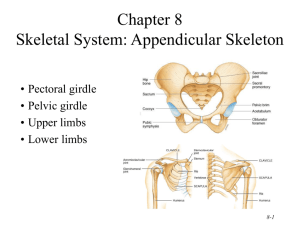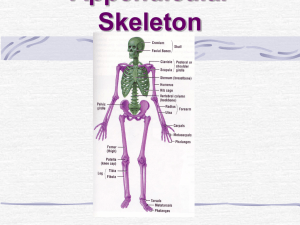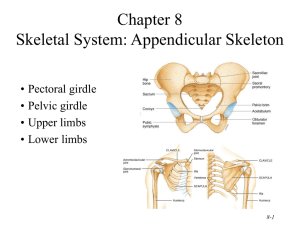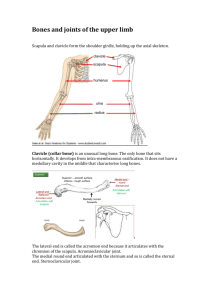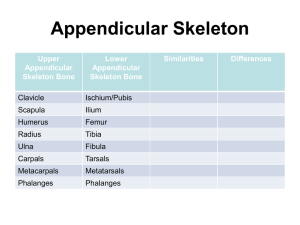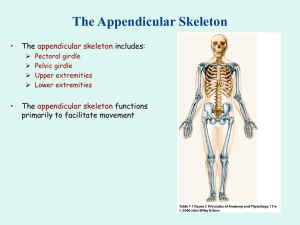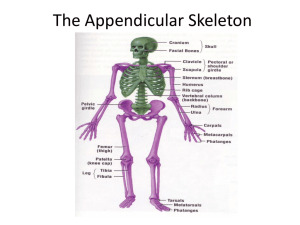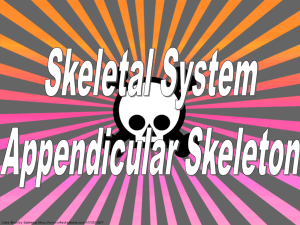10/12/2010 Pectoral (Shoulder) Girdle Skeletal System: Appendicular Skeleton Pectoral girdle
advertisement
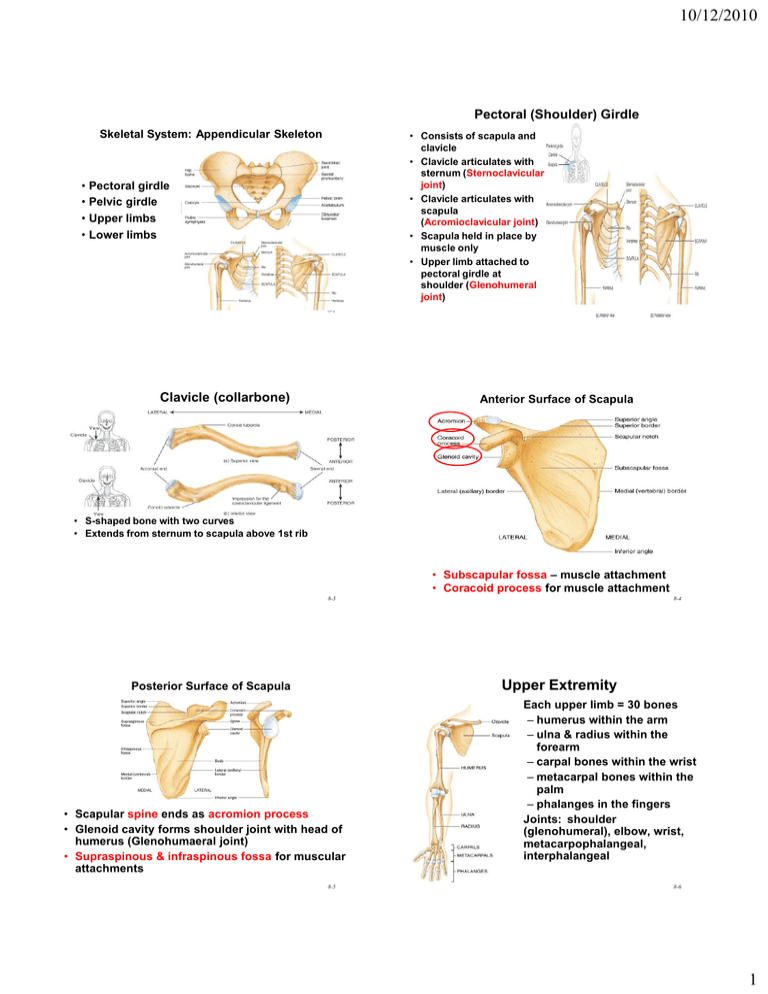
10/12/2010 Pectoral (Shoulder) Girdle Skeletal System: Appendicular Skeleton • Consists of scapula and clavicle • Clavicle articulates with sternum (Sternoclavicular joint) • Clavicle articulates with scapula (Acromioclavicular joint) • Scapula held in place by muscle only • Upper limb attached to pectoral girdle at shoulder (Glenohumeral joint) • Pectoral girdle • Pelvic girdle • Upper limbs • Lower limbs 8-1 Clavicle (collarbone) 8-2 Anterior Surface of Scapula • S-shaped bone with two curves • Extends from sternum to scapula above 1st rib • Subscapular fossa – muscle attachment • Coracoid process for muscle attachment 8-3 8-4 Upper Extremity Posterior Surface of Scapula • Scapular spine ends as acromion process • Glenoid cavity forms shoulder joint with head of humerus (Glenohumaeral joint) • Supraspinous & infraspinous fossa for muscular attachments 8-5 • Each upper limb = 30 bones – humerus within the arm – ulna & radius within the forearm – carpal bones within the wrist – metacarpal bones within the palm – phalanges in the fingers • Joints: shoulder (glenohumeral), elbow, wrist, metacarpophalangeal, interphalangeal 8-6 1 10/12/2010 Humerus --- Distal End Humerus --- Proximal End • Part of shoulder joint • Head & anatomical neck • Greater & lesser tubercles for muscle attachments • Intertubercular sulcus or bicipital groove • Deltoid tuberosity • Body (Shaft) • Forms elbow joint w/ ulna and radius • Capitulum – articulates with head of radius • Trochlea - articulates with the ulna • Medial epicondyle • Lateral epidcondyle 8-7 Ulna & Radius --- Proximal End 8-8 Ulna & Radius --- Proximal end •Ulna (on little finger side) – trochlear notch articulates with humerus & radial notch with radius – olecranon process = point of elbow • Radius (on thumb side) – head articulates with capitulum of humerus & radial notch of ulna 8-9 Elbow Joint - Review 8-10 Ulna and Radius – Distal end Radioulnar joint • • • • Articulation of humerus with ulna and radius Ulna articulates with trochlea of humerus Radius articulates with capitulum of humerus Interosseous membrane between ulna & radius provides site for muscle attachment 8-11 • Ulna - head separated from wrist joint by fibrocartilage disc • Radius: forms wrist joint with scaphoid, lunate & triquetrum (3 carpal bones) 8-12 2 10/12/2010 8 Carpal Bones (wrist) • Proximal row - lat to med 1. scaphoid boat shaped 2. lunate - moon shaped 3. triquetrum - 3 corners 4. pisiform - pea shaped 8-13 8-14 Metacarpals and Phalanges 8 Carpal Bones (wrist) • Distal row - lateral to medial 5. trapezium - four sided 6. trapezoid - four sided 7. capitate - large head 8. hamate - hooked process Pollex • Metacarpals – 5 total----#1 proximal to thumb – base, shaft, head – knuckles (metacarpophalangeal joints) • Phalanges – 14 total: each is called phalanx – proximal, middle, distal on each finger, except thumb – base, shaft, head 8-15 Ilium Pelvic Girdle and Hip Bones • Pelvic girdle = two hipbones united at pubic symphysis – articulate posteriorly with sacrum at sacroiliac joints - 8-16 Each hip bone = ilium, pubis, and ischium • Iliac crest, spines, & Iliac fossa for muscle attachment • Sacroiliac joint (sacrum articulates with ilium) • Greater sciatic notch for sciatic nerve • Pelvis = 2 hip bones, sacrum and coccyx 8-17 8-18 3 10/12/2010 Pubis and Ischium Female and Male Skeletons • Male skeleton • Pubis – larger & heavier – larger articular surfaces – larger muscle attachments – pubic arch < 900 pubic symphysis is pad of fibrocartilage • Ischium • Female pelvis – wider & shallower – larger pelvic inlet & outlet – pubic arch >900 8-19 Female 8-20 Lower Extremity Male • Each lower limb = 30 bones – femur and patella within the thigh – tibia & fibula within the leg – tarsal bones in the foot – metatarsals within the forefoot – phalanges in the toes • Joints – hip, knee, ankle – proximal & distal tibiofibular – metatarsophalangeal 8-21 Femur and Patella • Femur (thighbone) – head articulates with acetabulum (attached by ligament) – greater & lesser trochanters, – medial & lateral condyles articulate with tibia – patellar surface anteriorly between condyles 8-22 Patella - triangular sesamoid 8-23 8-24 4 10/12/2010 Tibia and Fibula • Tibia – medial & larger bone of leg – lateral & medial condyles – tibial tuberosity for patellar ligament – proximal tibiofibular joint – medial malleolus at ankle Fibula – is not part of knee joint - It provides muscle attachment only - Lateral Maleolus articulates with Talus (that lateral bulge on your ankle) 8-25 8-26 Tarsus • Proximal region of foot (contains 7 tarsal bones) • Talus = ankle bone (articulates with tibia & fibula) • Calcaneus - heel bone • Cuboid, navicular & 3 cuneiforms 8-27 Metatarsus and Phalanges • Metatarsus – midregion of the foot – 5 metatarsals (1 is most medial) – each with base, shaft and head • Phalanges – distal portion of the foot – similar in number and arrangement to the hand – big toe is hallux 8-28 Arches of the Foot • Function: – distribute body weight over foot – yield & spring back when weight is lifted • Longitudinal arches along each side of foot • Transverse arch across midfoot region – navicular, cuneiforms & bases of metatarsals 8-29 5
